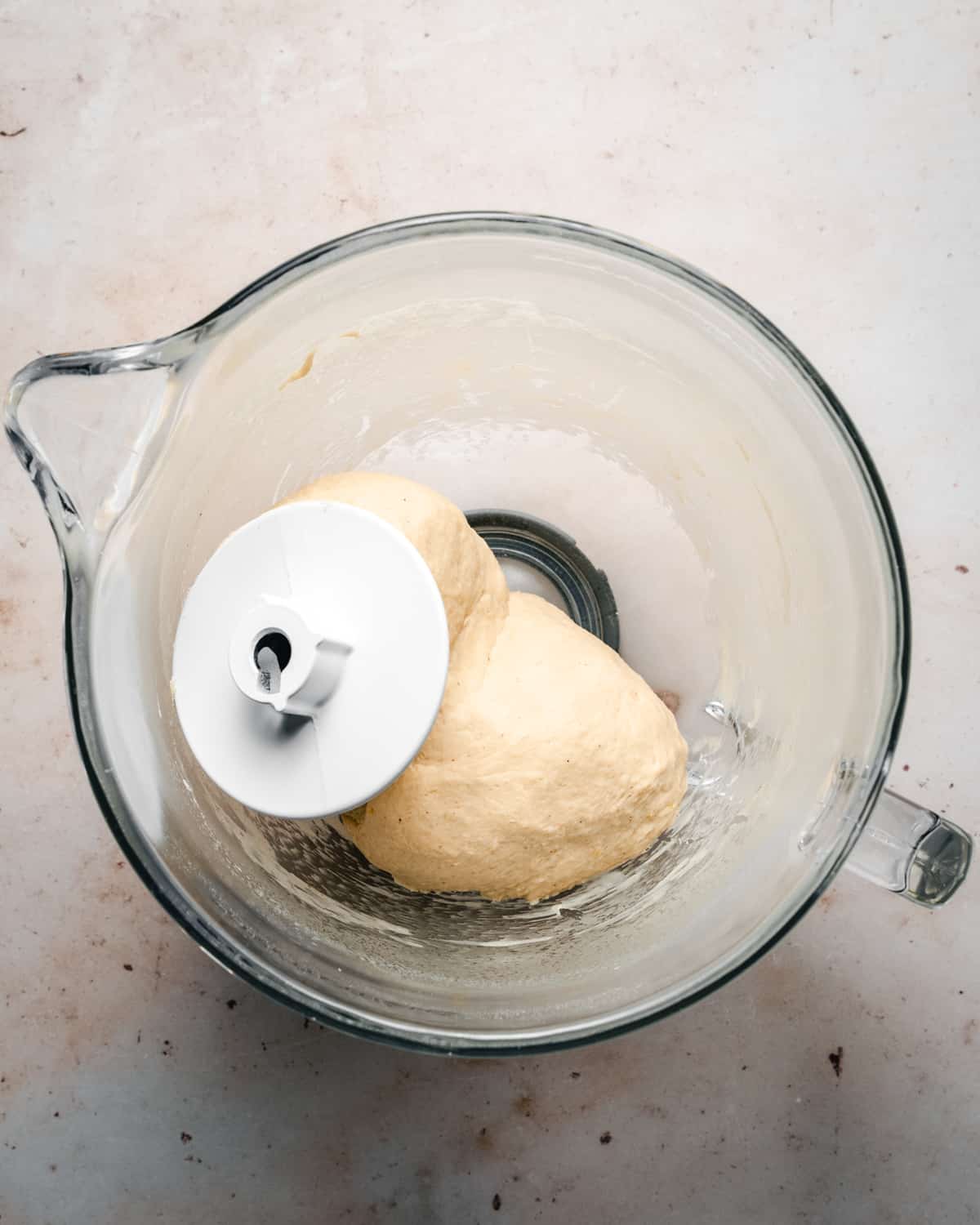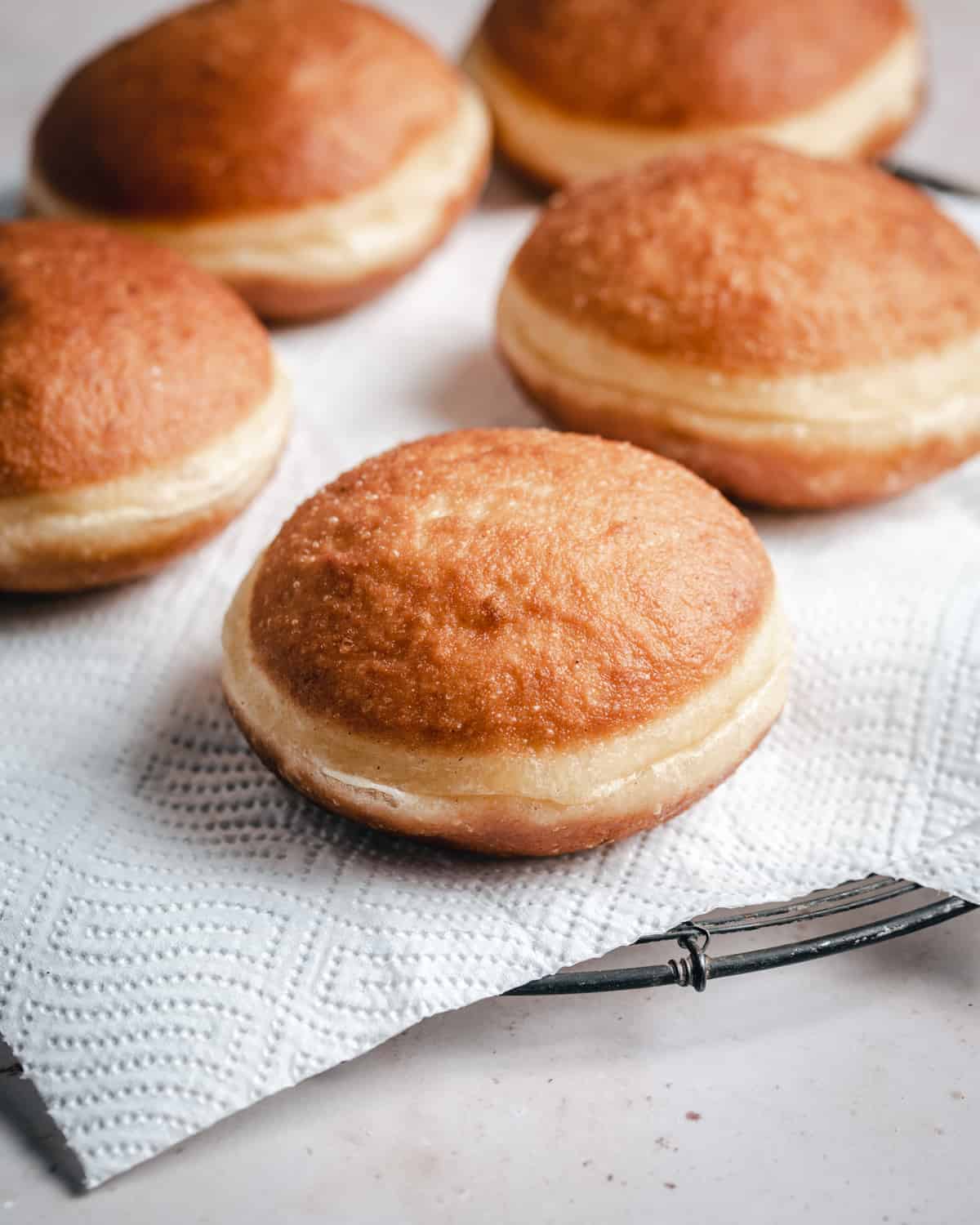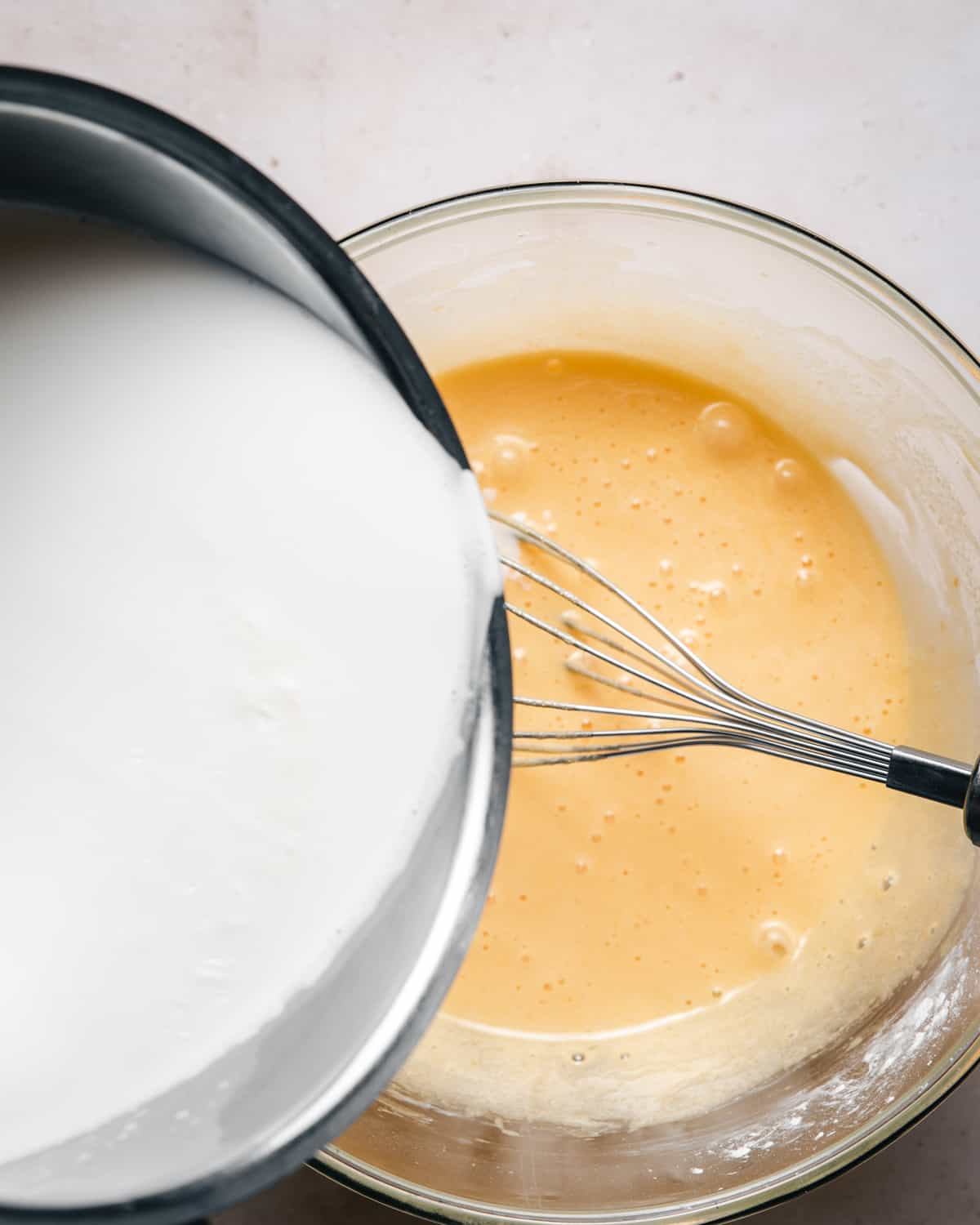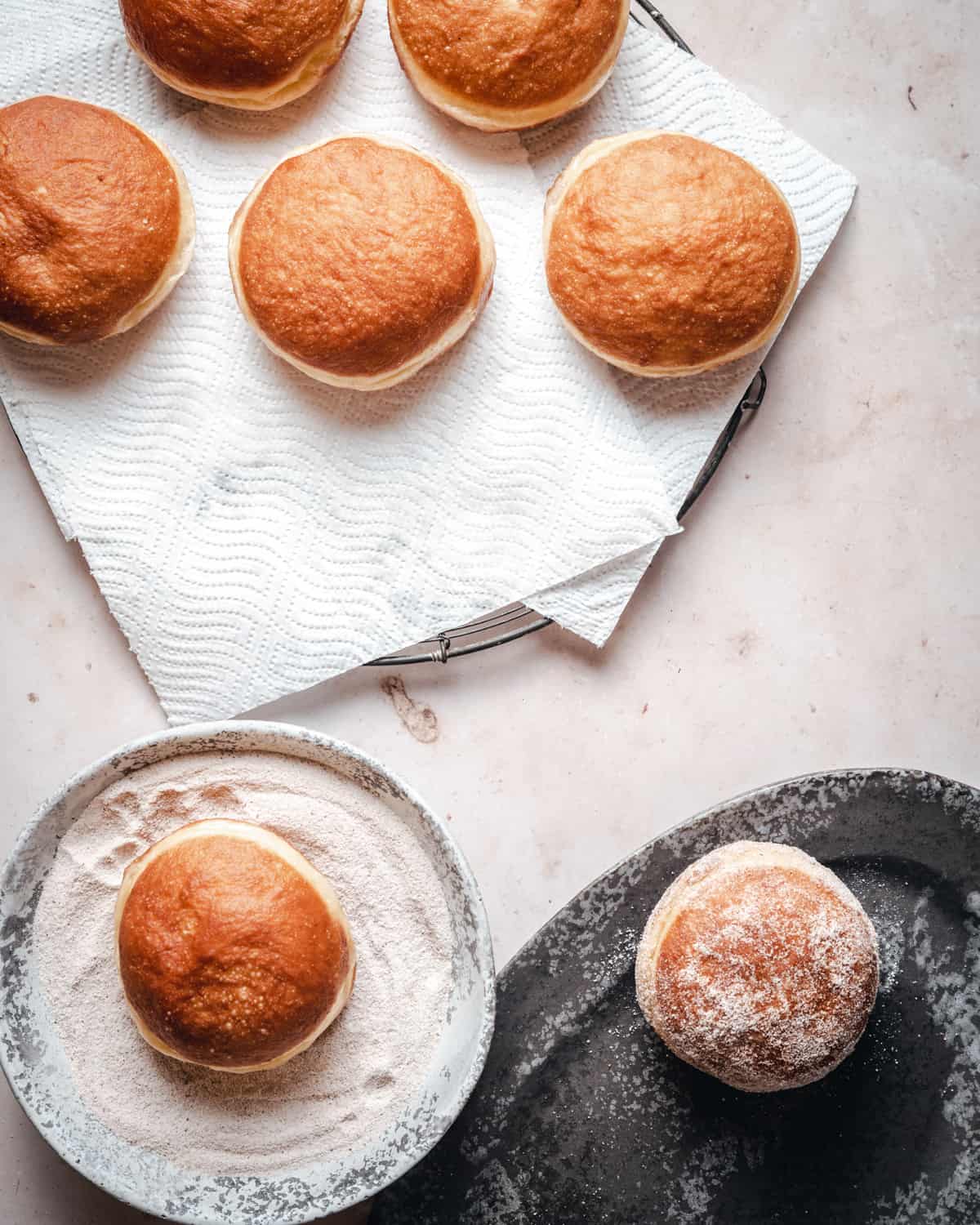Look no further for a top-notch Bavarian cream doughnut recipe, with the fluffiest, most delicious dough and silky, creamy Bavarian cream filling.

To rewind a bit—I started this blog out of a love for cakes and a desire to learn how to properly make dough-based sweets and desserts.
Now that I've somewhat mastered the topic of cake making and with a cake cookbook behind me, I needed a new baking project and it was the best time to tackle dough making.
And what a better way to start, than with everyone's favorite—DOUGHNUTS!
At first, I wanted to create a perfect fried vegan doughnut recipe and then I moved forward to the buttery brioche goodness. I already have a doughnut recipe on my blog that was based on more traditional Croatian doughnut making. It's a good recipe, but... oh my. This is something else!
This time I dug deep to really understand gluten development, ratios, the importance of kneading long enough, adding enough fat to produce the most tender, brioche-like dough and so on.
After a few months of testing and making almost a thousand doughnuts (no kidding), I'm ready to share this recipe/guide for Bavarian cream filled doughnuts with you! 🙂
Jump to:
Why you'll love these Bavarian cream doughnuts
- they're incredibly soft and full of flavor, even when eaten without the filling
- the process includes overnight proofing, which makes it easier for you to distribute the workload and creates a complex depth of flavor
- the Bavarian vanilla cream filling is absolutely delicious and versatile
- they're great for birthdays, baby showers and any other special occasions
- you don't need any special ingredients, just a little bit of patience and time
Ingredient notes
Here's what you'll need to make these EPIC Bavarian Cream doughnuts. Feel free to screenshot it before going to the grocery store 😉
- All-purpose flour: I always aim to develop recipes with the flour available to most people. All-purpose flour differs between brands, so my best advice is to use the one that has the highest protein content.
- Liquid: I find that water works best in my doughnut recipes and there is no need for milk or other types of liquid.
- Sugar: fine granulated sugar or caster sugar is best for baking, but if you can't find any, regular white granulated sugar will work great too.
- Yeast: It doesn't matter if it's dried or fresh, both will work great in this recipe. Usually one packet is enough for 500 g of flour, so I add just a tiny bit more from another packet because I have more flour and a very rich dough that needs longer to proof.
- Salt: I always use fine sea salt in my recipe. Don't forget to add it both to the dough and the filling, salt is a flavor enhancer and it makes everything so much better.
- Dark rum: I've always added some alcohol to my doughs and pancakes because that's what I've learned from my grandmother. It helps with avoiding soaking up the oil + I love the flavor of rum! Traditionally, people in Croatia would use rakija. 🙂
- Lemon zest: I rarely make anything without adding some lemon or orange zest to it. It's the best, it gives so much flavor and I recommend adding some. I had some organic lemons from Dubrovnik and they smelled SO good!
- Eggs: when I started developing this recipe I quickly realized that I wanted to use whole eggs, because I already had so much leftover egg white. I usually use large eggs in my baking, but I've switched to organic eggs from local farms and they come in various sizes. For that reason, I wrote the egg measurement for the dough in grams.
- Nutmeg: a little ground nutmeg goes a long way in producing that perfect doughnut aroma.
- Vanilla: always use extract/paste and not essence.
- Unsalted butter: a staple in my baking, European-style butter with at least 82% fat and 16% of water content.
- Milk: you'll need some to make the pastry cream. I recommend using whole milk. It has the best flavor.
- Cornstarch: I use it as a thickening agent in the pastry cream.

How to make the doughnut dough (step-by-step)
Note: You have the fully written recipe with measurements and detailed instructions at the end of the post. However, I advise you to read all the helpful tips and FAQs.
I hope the visual cues of each phase the dough goes through will be helpful to you. This is a pretty rich dough, so it needs a bit of time to properly develop.
I recommend using a stand mixer with a dough hook attachment. A regular KitchenAid Artisan with a 5qt (4.8L) bowl will do great (approx. 25 minutes from start to finish) and if you have a KitchenAid Heavy Duty mixer, that one will do an even better (quicker) job (approx. 15 minutes from start to finish). This is not sponsored, I just personally own and use both of these mixers. 🙂
For those of you that don't have a stand mixer, you can try and use an electric hand mixer with dough kneading attachments, but pay attention to possible overheating of the mixer.
There is also always a possibility of kneading the dough by hand, however it will require quite a bit of time and muscle.
Without further ado, here's how you make the most pillowy, delicious doughnuts:



- Start by adding the lukewarm water, sugar, yeast, rum, lemon zest, vanilla and eggs to the bowl of a standing mixer. Then add the dry ingredients - flour, salt and ground nutmeg. It's important that the yeast doesn't come to direct contact with the salt.
- Using a dough hook attachment, start kneading at low speed. The ingredients will start clumping together into a dough and look somewhat dry and rugged like pictured.
- However, just continue with the kneading for 5-8 minutes and the dough will become smooth and more elastic and pull away from the sides of the bowl.
The reason we're not adding the butter from the start is to make it easier for the dough to develop gluten and become soft and elastic.
Now that we've allowed the dough to develop some gluten, it's time to start adding the butter, one cube at a time. In this process, the dough will go through various phases, but just keep going and be persistent.



- At first, as we start adding the butter, the dough will start looking like it's separating and the butter is just getting smeared on the sides of the bowl, but don't worry.
- Eventually, the dough will start "accepting" the butter and it will become a sticky mess. Still, trust the process.
- When you've added all the butter, knead for another 5 to 10 minutes, or until it's once again smooth, elastic and not sticking to the sides of the bowl.
- Then, take the dough out of the bowl and "slap-and-fold" it a few times on a clean surface, until you form a smooth, glossy ball of dough.
- Place the dough in a slightly greased bowl, cover with cling film and put in the fridge to proof overnight, approx. 12 to max 18 hours. The dough will have doubled in size.
Slow, cold fermentation helps with developing a more complex flavor, fluffier texture and better digestibility.




- Once the dough is ready, punch it down to deflate it and transfer it to a lightly floured surface. Give it a short knead and then form your doughnuts. I always use a kitchen scale and measure 60-65 g balls.
TIP for rolling the balls: using the inside of your hand, firstly press the piece of the dough to get rid of the residue air bubbles and then start rolling with your hand in a "claw" shape. Don't press too much, you want your hand to act as a "shield", as a space for that dough to shape itself. If possible work on the faster side as this will help produce tight, smooth balls.
- Place the doughnuts on lightly greased squares of baking paper. If proofing at room temperature, cover loosely with cling film (so they don't dry out). On the other hand, if you're using your oven, covering is not necessary. (Check tips below!)
- Leave to rest for approx. 3h to double, almost triple in size. They're done proofing when they're quite big and you can press one with your finger, gently, and it keeps the indentation visible.


- Deep fry the doughnuts for a couple of minutes on each side, until beautifully golden brown.
- The top of the doughnut should be the first side to touch the oil. The bottom (the side that's touching the baking paper square) will then become the top and wait for its turn in the oil. 🙂
- Transfer to a wire rack or a plate with paper towels and let cool slightly before rolling into sugar and filling.
Note: Don't worry if the doughnuts slightly deflate after frying and the white ring becomes wrinkly. This is a good thing because it means they're very fluffy AND you have room to fill them with delicious Bavarian cream and make them plump again! 🙂
What is Bavarian cream?
In the world of French pâtisserie, it's known as crème bavarois and it represents a custard-based dessert that is thickened with gelatine and mixed with whipped cream. It's mostly served as a stand-alone dessert in glasses or shaped into molds like panna cotta.
However, as a doughnut filling most Americans are familiar with today, Bavarian cream is simply pastry cream lightened with whipped cream—also known as Diplomat cream or crème légère.
If you are fond of the Bavarian cream donuts they offer at Dunkin' Donuts, you are going to love these!
Here's how to make Bavarian vanilla cream filling for doughnuts.
How to make doughnut cream filling
If you've ever made pastry cream before, this will be a breeze. But just in case, I included some step shots to visualize the process!





- Whisk the egg yolks, egg, sugar, corn starch and salt in a medium-sized bowl.
- Meanwhile, let the milk come almost to a boil and then, in a slow and steady stream, whisking constantly, add about ⅔ of the hot milk to the egg mixture.
- Once you tempered the egg mixture, return it back to the saucepan with the remaining milk and continue cooking, whisking constantly, until it thickens and then proceed cooking for another minute or two to make sure the cornstarch-y flavor is gone.
- Turn the heat off, add the butter and vanilla and whisk until everything is incorporated, smooth and shiny.
- Pour the pastry cream to a shallow plate and cover with plastic wrap touching the surface (to prevent skin forming). Leave to cool at room temperature for an hour before placing in the fridge to cool completely.
TIP: To make sure your pastry cream is smooth and silky, strain it through a sieve to get rid of any lumps or potentially cooked egg bits.


- When you're ready to fill the doughnuts it's time to finish the filling. Transfer the cold pastry cream to a mixing bowl (it will be stiff, gelatinous-like) and give it a mix with an electric hand mixer to make it creamy again.
- In a separate bowl, whisk the cold heavy cream to stiff peaks and add it to the pastry cream. Mix everything together at medium-high speed until fully combined and smooth.
- Place the Bavarian cream in a disposable piping bag and snip the end off before using. There is no need for a piping nozzle.
Finishing the doughnuts
Now comes the best part, a reward for all your hard work 🙂


Coat the doughnuts in cinnamon sugar and place them vertically in a baking pan covered with baking paper.
Using a small knife or scissors, cut the doughnuts in the middle (where the white line is) to make space for the cream.
Fill with the prepared vanilla cream. You'll know you've filled them enough when they start expanding! 🙂

💡My top tips
- I highly recommend using a candy thermometer (or a digital thermometer) when frying. Doughnuts should be fried at a certain temperature. If the oil is too cold, the doughnuts will turn out too greasy. If the oil is too hot, the outside will cook much faster than the inside, so you'll likely end up with raw, doughy doughnuts that have a deep brown crust. For the best result, aim for temperatures between 170°C (340°F) and 180°C (355°F). That will give your doughnuts the perfect golden color and fluffy inside. Don't go below 165°C.
- Don't overcrowd the pot with doughnuts, because they need room to rise. Also, the more you put in, the temperature of the oil decreases which is where the thermometer comes in handy.
- Make sure the water isn't too hot, otherwise it will kill the yeast and your dough won't rise. When it comes to dry yeast, you can use either an instant yeast or active dry yeast, but the latter needs to be activated before use. You can also use fresh yeast.
- Doing an overnight proof not only helps with bettering the flavor, texture and digestibility of the doughnuts, but it makes it easier for you to organize and make better use of your time.
- Use your oven as a fermentation chamber of sorts. Preheat it to 30°C (85°F) and turn it off before placing the doughnuts to proof inside. A lot of people recommend just keeping the light on—unfortunately I haven't been able to test this because my light hasn't been working for the past 5-6 years. 😀 Depending on the temperature and humidity, the shaped doughnuts (second proof) will need anywhere from 2 to almost 4 hours to fully rise. It's a lot, but it's so worth it!
- Always transfer the fried doughnuts on a few pieces of paper towel to soak up any oil residue.
- Don't be tempted to add more flour in order to speed up the kneading process. It takes time for gluten to develop, but once it does, trust me—the dough will become shiny, smooth and not sticky at all. You will be able to handle the dough with your hands and not one piece of the dough will stick to your skin. Just be patient and let the mixer do its thing!
- If you don't have caster sugar, use your blender to pulse granulated sugar a few times and make it very fine, but not powdered. This kind of sugar works best for the cinnamon sugar coating.
- Be very gentle when transferring the doughnuts to the pan because you don't want to deflate them and lose all the precious air pockets. That's why I recommend placing the doughnut balls on an individual squares of baking paper before proofing. It makes the frying process so much easier and the doughnuts keep their perfect round looks!
- Slide the doughnuts from the baking paper upside down. The top of the doughnut should be the side to touch the oil first!
Yield and serving variations
This recipe makes 18-19 doughnuts that weigh between 60-65 grams or 23 smaller doughnuts that weigh 50 grams.
Feel free to spice things up a bit and add some lemon or orange zest to the doughnut cream filling.
Or even better - fill the doughnuts halfway then squeeze some raspberry jam in the middle and finish with cream and crushed freeze-dried raspberries as garnish! If you want to make your own jam, don't miss my recipe for delicious homemade raspberry jam.
Storing
The doughnuts are best the day they're made, however, they will keep okay for a couple of days in an airtight container either at room temperature or in the fridge. Any longer than that and the dough will dry out and won't be as fluffy and beautiful as on the day made.

FAQs and troubleshooting
Bavarian cream doughnuts are rolled in (powdered) sugar and made with pastry cream that has been mixed with whipped cream. Boston cream doughnuts are filled with vanilla pastry cream and dipped in chocolate.
Generally speaking the best oil is the one that has a neutral flavor, high smoke point and is available to you. For me that's sunflower oil, in the US that would be canola oil.
The temperature of the oil is too low or the doughnuts are over-proofed, so they lack structure and stability and thus soak up a lot of the oil.
The frying temperature of the oil is too high and causes the outside to brown quickly, which leaves the middle uncooked because you don't want to eat burnt doughnuts. I advise you to buy a kitchen thermometer, it's a life saver!
Unfortunately, they've been over-proofed and lack the structure to hold the shape. The best way to know if your doughnuts are proofed (aside from visually doubled in size) is to lightly press them with your finger. If they hold the indentation and don't bounce right back, they're ready!
You probably haven't kneaded it long enough. I know I've made this mistake before, but just keep kneading. It can take up to half an hour to properly knead it!
If you have any other questions that I didn't cover, please let me know in the comments section down below - I'd love to help you out!
And if you make these Bavarian cream doughnuts, tag me on Instagram @anasbakingchronicles so I can see it or feel free to e-mail me your pictures and thoughts! I love seeing your bakes!
Happy baking,
Ana
📖 Recipe

Bavarian Cream Doughnuts
Description
ingredients
- 200 g lukewarm water
- 12 g dark rum (approx. 1 Tbsp)
- ½ teaspoon vanilla extract or paste
- 80 g granulated sugar
- 20 g fresh yeast (or 9 g instant dry yeast)
- zest of one lemon
- 150 g eggs (approx. 3 medium eggs)
- 600 g all-purpose flour
- ¼ teaspoon ground nutmeg
- 8 g fine sea salt
- 150 g unsalted butter (room temperature)
- 1.5 liters sunflower or canola oil (for frying)
- 200 g caster sugar*
- 2 teaspoons ground cinnamon
Bavarian Cream Filling
- 500 g whole milk
- 4 large egg yolks
- 1 large egg
- 45 g corn starch
- 150 g granulated sugar
- ½ teaspoon fine sea salt
- 1 teaspoon vanilla extract or paste
- 30 g unsalted butter
- 200 g heavy cream (cold)
Instructions
To make the dough:
- In the bowl of a stand mixer, add the lukewarm water, sugar, yeast, lemon zest, rum, vanilla extract and eggs. Give it a stir with a fork or a whisk.If you're using active dry yeast, make sure to firstly activate it by combining with water and a teaspoon of sugar. Leave for a few minutes until the top is frothy, then proceed adding the other ingredients per instructions.
- Fit the stand mixer with the dough hook and add the flour, salt and nutmeg to the bowl. Knead the dough for approx. 5-8 minutes, on low-medium speed, until it becomes smooth, shiny and doesn't stick to the sides of the bowl.
- Next, add in the butter, one cube at a time, with the mixer still going at medium-low speed. It will seem like it's not incorporating together, but don't worry, just keep adding it, and it will eventually start coming together, creating a sticky dough.
- Once you've added all the butter and the dough is combined, but sticky, continue to knead it on low-medium speed for another 5 to 10 minutes, or until it becomes smooth and elastic again, and starts pulling away from the sides.
- Transfer the dough to a large bowl that you've previously floured or lightly greased so it doesn't stick. Cover with cling film and put in the fridge to proof overnight.
- Once your dough is ready, punch it to deflate it, transfer it on a clean, lightly floured surface and give it a brief knead. Portion the dough into approx. 18 pieces that weigh between 60 to 65 grams. (I always use a kitchen scale for this)Roll each piece of dough until you've got a smooth ball and place on a baking sheet with individual baking paper squares. Cover with a clean tea towel or plastic wrap and let them rest and rise for another 2 to 4 hours. (The exact time will depend on how warm and humid is the space you're letting them proof.)
- You don't want to overproof your doughnuts, otherwise they will become hollow inside and soak up a lot of oil. When the dough is ready, heat approx. 1.5 liters of vegetable oil in a heavy-bottomed pan. The oil should be between 170 and 180 degrees Celsius. That's around 340 to 350F.
- Fry 3-4 doughnuts at a time for a couple of minutes on each side or until golden. Take them out to a plate covered with paper towels. Let them cool completely before filling and covering with sugar.
To make the Bavarian cream filling:
- In a medium-sized saucepan, heat the milk just until boiling point.
- In the meantime, in a separate bowl, combine the egg yolks, egg, corn starch, sugar and salt using a whisk.
- Once the milk has reached scalding point, pour ⅔ of it to the egg mixture, in a slow and steady stream, whisking continuously so you don't cook the eggs. Once you tempered the egg mixture, return it to the saucepan with the remaining milk and continue cooking, whisking constantly, until it thickens.Cook for another 1-2 minutes to make sure there isn't any cornstarch aftertaste.
- Once it's done, add in the vanilla and butter and whisk until everything is combined, silky and smooth.
- Strain the pastry cream to a clean bowl through a sieve, to get rid of any cooked egg bits and lumps. Cover with cling film (plastic wrap) touching the surface to prevent skin forming. Let it cool at room temperature for about an hour, then place it in the fridge to cool completely.
- Transfer the cold pastry cream to a mixing bowl (it will be stiff, gelatinous-like) and give it a mix with an electric hand mixer to make it creamy again.In a separate bowl, whisk the cold heavy cream to stiff peaks and add it to the pastry cream. Mix everything together at medium-high speed until fully combined and smooth.
- Place the Bavarian cream in a disposable piping bag and snip the end off before using. There is no need for a piping nozzle.
Assembly:
- Coat the doughnuts into a cinnamon-sugar mixture and place vertically on a baking tray. Using a small knife or scissors, cut the middle (where the white line is) to create a hole for the filling. Fill with the prepared vanilla cream. You'll know you've filled them enough when they start expanding! 🙂
Notes
- If you don’t have a stand mixer, you can use an electric hand mixer with dough kneading attachments, a wooden spoon or your hands!
- If you still don’t own one, I advise you to buy a kitchen scale – they’re cheap and easy to use, and always guarantee the same results in baking! 🙂
- Please check the post for extra tips and information!
IMPORTANT
All the recipes are developed and tested using only metric measurements and a kitchen scale. The U.S. cup and spoon measurements are provided for your convenience, but I highly recommend getting a digital kitchen scale and measuring in metrics. It's easy and always guarantee the same results in baking!
Nutrition
The nutritional information and US conversions are calculated automatically. I cannot guarantee the accuracy of this data. If this is important to you, please verify with your favourite nutrition calculator and/or unit conversion tool.







Robert
👍👍👍
A.A
Is there a possible replacement for dark rum?
Ana Zelić
Hi,
you can use brandy, bourbon, whiskey or something similar. Or, if you don't want to use alcohol at all, just add more water instead to keep the liquid ratio the same.
Hope this helps! x
Neda
I made my dough, but it is sticking everywhere. It never pulled away from the bowl. What would be wrong with it?
Ana Zelić
Hi Neda,
I think you answered your own question. 🙂
The dough hasn't pulled away from the bowl, which means that you didn't knead it long enough and that's the reason it's too sticky -- Not enough gluten formation.
Beth
Hi. My dough is rising now and I just realized I don't have any heavy cream. Is there a substitute I can use in the filling.
Ana Zelić
Hi Beth,
you can omit the heavy cream and just use the pastry cream as the filling, but you might not have enough to fill all the doughnuts!
Also, bear in mind that the heavy cream lightens the filling and balances the sweetness, so without it, the filling could be a tad too sweet. I can't think of any good substitute for heavy cream in this case.
Kobus
I have tried twice both times it was perfect for curiosity sake can it be baked